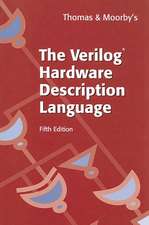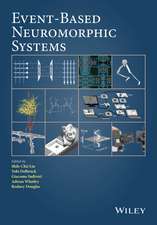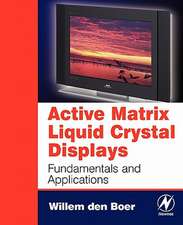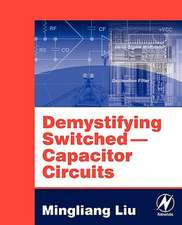Millimeter-Wave Integrated Circuits
Autor Eoin Carey, Sverre Lidholmen Limba Engleză Paperback – 28 oct 2010
| Toate formatele și edițiile | Preț | Express |
|---|---|---|
| Paperback (1) | 938.81 lei 6-8 săpt. | |
| Springer Us – 28 oct 2010 | 938.81 lei 6-8 săpt. | |
| Hardback (1) | 950.52 lei 6-8 săpt. | |
| Springer Us – 11 noi 2004 | 950.52 lei 6-8 săpt. |
Preț: 938.81 lei
Preț vechi: 1144.88 lei
-18% Nou
Puncte Express: 1408
Preț estimativ în valută:
179.69€ • 185.18$ • 151.70£
179.69€ • 185.18$ • 151.70£
Carte tipărită la comandă
Livrare economică 01-15 martie
Preluare comenzi: 021 569.72.76
Specificații
ISBN-13: 9781441936493
ISBN-10: 1441936491
Pagini: 288
Ilustrații: XVI, 272 p. 134 illus.
Dimensiuni: 155 x 235 x 15 mm
Greutate: 0.41 kg
Ediția:Softcover reprint of hardcover 1st ed. 2005
Editura: Springer Us
Colecția Springer
Locul publicării:New York, NY, United States
ISBN-10: 1441936491
Pagini: 288
Ilustrații: XVI, 272 p. 134 illus.
Dimensiuni: 155 x 235 x 15 mm
Greutate: 0.41 kg
Ediția:Softcover reprint of hardcover 1st ed. 2005
Editura: Springer Us
Colecția Springer
Locul publicării:New York, NY, United States
Public țintă
ResearchDescriere
Millimeter-Wave Integrated Circuits delivers a detailed overview of MMIC design, specifically focusing on designs for the millimeter-wave (mm-wave) frequency range. The scope of the book is broad, spanning detailed discussions of high-frequency materials and technologies, high-frequency devices, and the design of high-frequency circuits. The design material is supplemented as appropriate by theoretical analyses. The broad scope of the book gives the reader a good theoretical and practical understanding of mm-wave circuit design. It is best-suited for both undergraduate students who are reading or studying high frequency circuit design and postgraduate students who are specializing in the mm-wave field.
Cuprins
An Introduction to mm-Wave Integrated Circuits.- High Frequency Materials and Technology.- High Frequency Devices.- High-Volume mm-Wave Circuits.- Low Noise mm-Wave Amplifiers.- Monolithic Mixers.- Fet Frequency Multipliers.- Practical Monolithic Transceiver.- General Discussion and Future Trends.
Textul de pe ultima copertă
With the ever-increasing demand on wireless spectrum by wide bandwidth applications, such as third-generation mobile phones at RF frequencies, Multipoint Video Distribution System (MVDS) and Local Multipoint Distribution System (LMDS) in the millimeter-wave frequency range, there is a growing need to exploit higher and higher frequencies. The mm-wave field has therefore become a rapidly emerging area of research.
Millimeter-Wave Integrated Circuits explores the design and implementation of mm-wave integrated circuits using MMIC (Monolithic Microwave Integrated Circuit) technology. The main focal points are, firstly, fundamental circuit analyzes of building blocks necessary for the employment of MMIC technology for mm-wavelength applications, and, secondly, circuit design methodologies associated with these building blocks. The analytical/theoretical treatment is supplemented by specific mm-wave MMIC designs of varied complexity. The circuit designs presented have been fabricated on a commercial 0.25 m m GaAs pHEMT foundry process, thereby demonstrating that high volume, high quality mm-wave MMICs can indeed become a commercial reality.
Millimeter-Wave Integrated Circuits has a broad scope, and includes detailed discussions on high frequency materials and technologies, high frequency devices and the design of high frequency circuits, giving the reader a good theoretical and practical understanding of mm-wave circuit design. Key components of mm-waves transceiver circuits are studied and evaluated. Practical MMIC realizations, targeted for transceiver applications operating near 40 GHz and 57 GHz, have been fabricated and tested. They include low noise amplifiers (LNAs), balanced diode mixer for both up and down-conversion, balanced HEMT mixer as down-converter, HEMT frequency doubler, HEMT frequency tripler and a 57 GHz transceiver using integrated building blocks. Furthermore the viability of state of the art mm-wave processes for the generation of high power levels at 100 GHz is analyzed and a design topology suitable for a practical realization is presented.
Millimeter-Wave Integrated Circuits is written to support and supplement university mm-wave and high-frequency IC design courses, as well as serving as a reference for researchers and professional high frequency design engineers working in this exciting field of mm-wave integrated circuits.
Millimeter-Wave Integrated Circuits explores the design and implementation of mm-wave integrated circuits using MMIC (Monolithic Microwave Integrated Circuit) technology. The main focal points are, firstly, fundamental circuit analyzes of building blocks necessary for the employment of MMIC technology for mm-wavelength applications, and, secondly, circuit design methodologies associated with these building blocks. The analytical/theoretical treatment is supplemented by specific mm-wave MMIC designs of varied complexity. The circuit designs presented have been fabricated on a commercial 0.25 m m GaAs pHEMT foundry process, thereby demonstrating that high volume, high quality mm-wave MMICs can indeed become a commercial reality.
Millimeter-Wave Integrated Circuits has a broad scope, and includes detailed discussions on high frequency materials and technologies, high frequency devices and the design of high frequency circuits, giving the reader a good theoretical and practical understanding of mm-wave circuit design. Key components of mm-waves transceiver circuits are studied and evaluated. Practical MMIC realizations, targeted for transceiver applications operating near 40 GHz and 57 GHz, have been fabricated and tested. They include low noise amplifiers (LNAs), balanced diode mixer for both up and down-conversion, balanced HEMT mixer as down-converter, HEMT frequency doubler, HEMT frequency tripler and a 57 GHz transceiver using integrated building blocks. Furthermore the viability of state of the art mm-wave processes for the generation of high power levels at 100 GHz is analyzed and a design topology suitable for a practical realization is presented.
Millimeter-Wave Integrated Circuits is written to support and supplement university mm-wave and high-frequency IC design courses, as well as serving as a reference for researchers and professional high frequency design engineers working in this exciting field of mm-wave integrated circuits.
Caracteristici
Today, there is a lack of quality textbooks addressing the needs of the mm-wave IC designer.
This is not surprising given the explosive growth of the field, which is being fueled by the emergence of a number of high-volume mm-wave applications.
There is an urgent need for a textbook that provides a broad overview of the field, and at the same time delves in considerable detail into a number of key mm-wave circuit design topics.
The material on low noise amplifiers and frequency multipliers is particularly novel and should be of interest to the engineering community at large
This is not surprising given the explosive growth of the field, which is being fueled by the emergence of a number of high-volume mm-wave applications.
There is an urgent need for a textbook that provides a broad overview of the field, and at the same time delves in considerable detail into a number of key mm-wave circuit design topics.
The material on low noise amplifiers and frequency multipliers is particularly novel and should be of interest to the engineering community at large











